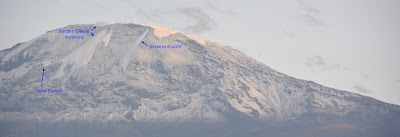This month's issue of KLM's in-flight magazine iFly has some nice photographs of climber Will Gadd, shot on Kibo's summit glaciers by Christian Pondella. One of these is above, showing the upper margin of Kersten Glacier as viewed from Uhuru Peak. Many summit climbers have enjoyed this view, with Mt. Meru ~70 km to the west through very clear air.
Despite continuing shrinkage of Kilimanjaro's glaciers, the steep margins remain impressive. For scale, the climber in this image indicates that the cliff is ~18 m or 60 ft. high. The meltwater lake at the base has been present there for many years. Has anyone ever seen it not frozen?
Most interesting here is how early-morning light highlights the stratigraphy of Kersten Glacier. As other perspectives also show, there are "bands" or "layers" of ice which are darker than those above or below. Thinking back through time, these likely formed when the surface was exposed for a period of time - probably years or decades - either due to no net snow accumulation (neutral mass balance) and/or to ablation (negative mass balance). Instead, dust accumulated and was subsequently buried during an interval of snow accumulation. Now exposed at the vertical wall, the high concentration of dust absorbs more solar radiation than the surrounding, relatively-clean ice, and absorbed energy leads to melting and sublimation -- highlighting the stratigraphy. Such features provide evidence of a complex ice history on Kilimanjaro.
Tuesday, December 15, 2015
Tuesday, December 8, 2015
Snowy November, slope glacier changes
During the month of November, net snow accumulation on the Northern Ice Field amounted to 19 cm. During this very strong El Niño year we expect additional snowfall through at least December, as the short rains continue. The image above shows fresh snowcover as seen from Moshi just after sunrise this morning (8 December 2015); thanks as always to Simon at SENE for keeping us updated.
Some readers may recall seeing other photos from Moshi posted here previously. Despite slight differences in lighting and snowline elevation, at first glance these appear quite similar. However, even at considerable distance, with thin snowcover, and a short 1-2 year timespan, changes in the glaciers are apparent upon close inspection.
Here are links to approximately the same view, one year ago (5 Dec. 2014; lower photo) and two years ago (24 Nov. 2013).
Three locations at which change is evident are labeled on today's image, including 1) Heim Glacier, a remnant of ice which was recently contiguous with ice to the left, and not long ago flowed nearly from the crater rim (as the Deckens does today); 2) Kersten Glacier, showing overall shrinkage in area with increasing separation of the upper and the slope remnants; and 3) Deckens Glacier, which will very soon become disconnected from the upper portion. All of these glaciers formerly comprised the Southern Ice Field.
Recession of other glaciers on Kilimanjaro also continues, based on annual field observations, GPS mapping, and imagery. The Furtwängler Glacier, for example, has been reduced to 4 fragments and continues to thin. At the Northern Ice Field - Kibo's largest ice body - the vertical margins continue retreating (ablating), and thinning of the glacier in some locations is creating new holes. Somewhat surprisingly however, this is not the case at the highest, flat section of the glacier. At the AWS, the 19 cm accumulation increase during November brings the ice surface to exactly the same elevation as it was on 1 Oct. 2011, meaning that the specific mass balance of that section has been neutral for 4 years! This portion of the Northern Ice Field will almost certainly be the last ice to disappear from the mountain.
Subscribe to:
Comments (Atom)




